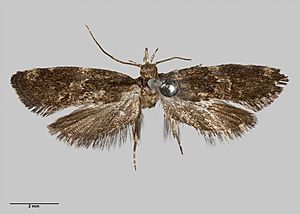Trachypepla nimbosa facts for kids
Quick facts for kids Trachypepla nimbosa |
|
|---|---|
 |
|
| Male holotype | |
| Scientific classification |
Trachypepla nimbosa is a species of moth in the family Oecophoridae. It is endemic to New Zealand. This species is classified as "Data Deficient" by the Department of Conservation. This species is only known from its holotype specimen.
Taxonomy
This species was described by Alfred Philpott in 1930 using a male specimen collected by Charles E. Clarke at Kauri Gully, Birkenhead on 13 January 1919. George Hudson discussed and illustrated this species in his 1939 book A supplement to the butterflies and moths of New Zealand. The holotype specimen is held at the Auckland War Memorial Museum.
Description
Philpott described this species as follows:
♂︎, 12 mm. Head and thorax purplish fuscous ; face mixed with ochreous. Palpi bright ochreous mixed with blackish, apex of terminal segment black. Antennae fuscous annulated with ochreous, ciliations in ♂︎2. Abdomen light purplish fuscous. Legs greyish fuscous mixed with ochreous, tarsi annulated with bright ochreous. Forewings elongate, costa moderately arched, apex rounded, termen rounded, oblique ; dark fuscous with some whitish ochreous admixture ; scale-tufts blackish tipped with ochreous (a basal one and plical and first discal spots) ; an obscure costa before apex : fringes concolorous with wing, but with faint darker basal line. Hindwings dark brownish fuscous : fringes dark fuscous with darker basal line.
Distribution
This species is endemic to New Zealand. This species has only been collected once the type locality of Kauri Gully.
Biology and behaviour
The adult of this species is on the wing in January.
Conservation status
This species has been classified as having the "Data Deficient" conservation status under the New Zealand Threat Classification System.

